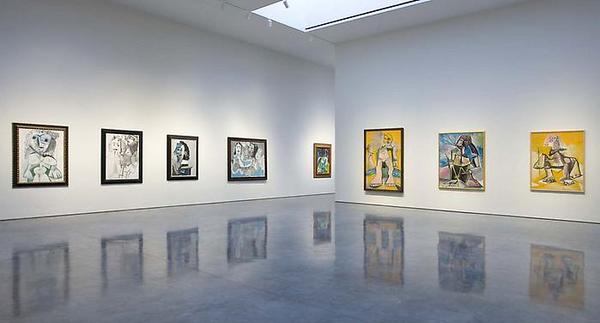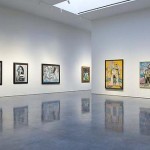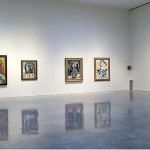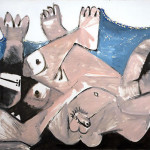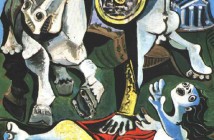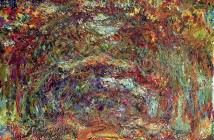The fantastic book "Old Masters and Young Geniuses" does something almost unheard of: Author David Galenson formulates the two distinct archetypes of modern art through economic criteria and data. For Galenson, modern artists can be differentiated with two distinct methods by which they arrive at their major contributions: "aesthetically motivated experience" and "conceptual execution." In general, "aesthetically motivated" artists are process based and aim to present visual perceptions. Yet, their goals are imprecise, making their procedures tentative and incremental. For painters, the final product may not be as important as what happened during the making of that same product. Speaking of the rather perfect fit that Cezanne occupies in this archetype, Galenson succinctly describes his process as "The total absorption in the pursuit of an ambitious, vague, and elusive goal." Because this approach is based on endless research and tireless experimentation, the overwhelming majority of these artists make their greatest contributions at the end of their careers.
In contrast, the conceptual innovator is motivated by a more precise set of ideas or criteria. Their goals can be stated beforehand in specific language or images, making the actual production of the work a foregone conclusion. Sol LeWitt might epitomize this most clearly, he even wrote a manifesto about this conceptual working procedure, however, Picasso epitomizes this type of innovation quite comfortably as well. While the "experimenter" generally arrives with their important accomplishments late, the conceptual innovator virtually always comes early. Les Demoiselles d' Avignon, arguably Picasso's single most famous work, came at a relative early part of his career. Furthermore, an astonishing decline in the importance of Picasso's work can be found when Galenson presents the number of all the illustrations of his work in textbooks published since 1968. Considering textbook illustrations, not to mention auction prices, Picasso declines at a rate that confirms both the idea that Picasso is a clear "conceptual innovator" and the art world has shown little interest in late Picasso.
However, interests can be fickle, and the art world, namely Gagosian Gallery, has recently made a push for "late Picasso", the very paintings not a single textbook produced in America or France since 1968 deemed worthy of publication. My interest here is not to evaluate the paintings themselves, but to look at the criteria and language that has been used to elevate, and thus canonize this late body of work. Several astounding reviews from important publications have accompanied this exhibition and, again, I have little interest in debating the relative merits each critic has brought to the discussion of the work, only how they characterize the work in relation to Galenson's archetype. We have witnessed, or are currently witnessing, the canonization of a body of work, and pairing this process with Galenson's model of Picasso provides some very striking contradictions.
Picasso always seemed to reject the description of his art as an evolution. As early as 1920, Clive Bell described his career as "a series of discoveries, each of which he has rapidly developed." His constant shift in styles has led down many paths of interpretation, including Meyer Schapiro's suspicion of him making Cubist painting in the morning and neoclassical paintings in the evening as a lack of integrity (this seems particularly strange in light of Gerhard Richter's ambivalence to style, no?) Picasso's ability to pick and choose styles to fit his ideas coincides with the galleries press release that states Picasso is again demonstrating "constant invention of the new, in terms of style, technique, and subject and, indeed, in relation to the history of his own creative output." In this light, Picasso is imaged as an old man, rigorously creating with the same conceptual acuity as he did as a youngster. Only now, we picture this process having been repeated for 70 something odd years. Picasso begins to resemble an experimental innovator, working through his paintings and finally coming to terms with the pictures through his process. Roberta Smith pictures "an artist gussied up like Rembrandt working from the model… It is as if the pressure of Picasso's final years generated its own weather system." This "pressure" to create a satisfying body of work at the end of one's career and life marks nearly all of the aesthetically experimental modern artists in the modern period including Kandinsky, Cezanne and Rothko. Yet, until recently and because of this show, Picasso would have never been put in this camp.
In a recent Artforum review, Carroll Dunham began his writing of the same exhibition by pointing to a wonderful irony: That during this economic meltdown, late period Picasso's are often the most desirable works. Quoting former Christie's Guy Bennett: "Picasso is still a cornerstone of the marketplace, and these later paintings are much sought after because they are both powerful and far more affordable than his early canvases." This quote juxtaposes quite interestingly with Roberta Smith's declaration that "This show should relieve doubts about the essential role of commercial galleries in a vital art scene." And what is this role? I will surmise that Smith is suggesting that Gagosian Gallery is fulfilling and expanding what is typical of a museum's role, which is to officially accept a body of work into the canon of art. (Earlier in her review she gushes that the exhibition "should make any museum glow green with envy.") And in these catastrophic economic times, museums need all the help they can get, even if it is simply providing more scholarly exhibitions, which Gagosian certainly has done. However, putting late Picasso in the heart of Chelsea is far from altruistic. Gagosian is presenting a pivotal re-reading of Picasso in the hopes that his archetype might be expanded, years of ignoring his late work finally be halted. There must also be a desire to expand Picasso's market, if the only thing worth buying happened before he turned 50, Gagosian might run out of buyers who can afford his work. Considering the positive reviews in both the New York Times and Artforum, one thing does seem clear: These late period Picasso's will not be "affordable" for long.
22
- Pablo Picasso, installation shot of Mosqueteros.
- Pablo Picasso, installation shot of Mosqueteros.
- Pablo Picasso, Étreinte, Oil on canvas, 1972
Gagosian Gallery
"Mosqueteros" was on view at Gagosian Gallery from March 26th - June 6th, 2009. All images are courtesy of Gagosian Gallery.

